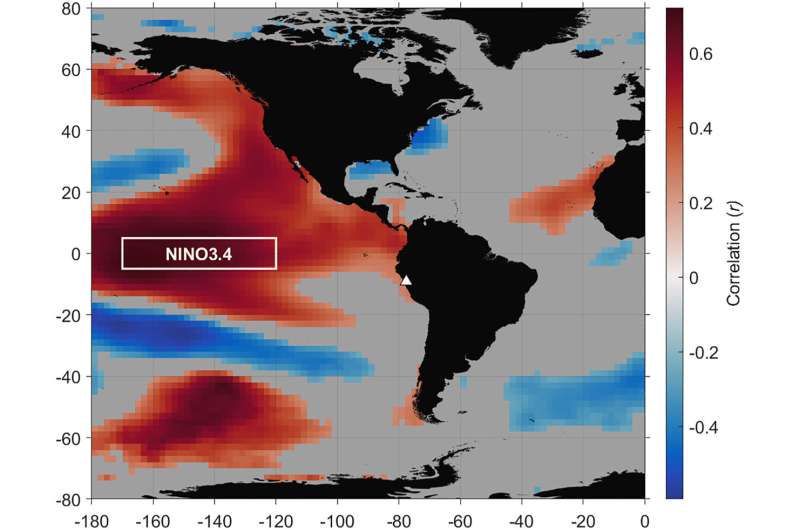This article has been reviewed according to Science X's editorial process and policies. Editors have highlighted the following attributes while ensuring the content's credibility:
fact-checked
peer-reviewed publication
trusted source
proofread
Ice cores from Earth's highest tropical peak provide insight into climate variability

In the first study to examine ice cores from the summit of the highest tropical mountain in the world, new evidence provides unique insight into the climate record of the Amazon Basin over the last six decades.
Nestled within the central Peruvian Andes lies Nevado Huascarán, a tropical mountain whose glaciers preserve the climate histories of the entire region. Researchers have long been interested in studying this area, because unlike ice cores recovered from the poles, core samples taken from tropical areas of the world can reveal a wealth of information about phenomena like El Niño and seasonal monsoons.
The study, by researchers from The Ohio State University and published in Journal of Geophysical Research: Atmospheres, involves four ice core samples—two from mountain col, which is the lowest point between two ridges, and for the first time, two from the summit, nearly 7,000 meters above sea level.
The researchers compared the oxygen-stable isotope records preserved in glacial ice at these different elevations on the mountain. Scientists who study ice cores use isotopes as a proxy for temperature change over time, but in tropical regions interpreting the isotope records can be a more complex process.
Their findings showed that the isotope records share a statistically significant relationship with sea surface temperatures in the Pacific and with rainfall over tropical South America. The oxygen-stable isotopes from the summit were also found to be more sensitive to large-scale changes in tropical Pacific sea surface temperature than the ones found at the lower levels of the mountain.
This is significant because it suggests that depending on the elevation, past climate histories recorded by the oxygen-stable isotopes may reveal different mechanisms or stories about the region. Overall, their results suggest that the influence of tropical Pacific climate on the summit isotope records is increasing, likely due to the rapid rates of climate change observed in recent decades.
"From a paleo-climate perspective, the data tells us that these cores may be useful for looking at the history of El Niño in the tropics," said Austin Weber, lead author of the study and a Ph.D. student at the Byrd Polar and Climate Research Center at Ohio State. "And we don't really have very good histories of that because there are not many observational data sets or historical records for the tropics."
During the years designated El Niño—when sea surface temperatures in the equatorial Pacific are anomalously warm—trade winds weaken and cause less rainfall to occur in the Amazon Basin, said Weber. "And if there's less precipitation, the isotopes are going to fractionate differently than normal," he said.
It's well known that temperature and precipitation amount are major factors that affect the size of glaciers, Weber said. But, over the past 60 years, temperatures have been rising significantly, pushing the ice on Nevado Huascarán into an accelerated retreat.
This is devastating news, said Lonnie Thompson, co-author of the study and a senior research scientist at the Byrd Polar and Climate Research Center, considering that tropical ice core samples can act as important proxies for understanding Earth's intricate ocean-atmosphere system.
"The beauty of these ice cores is that they give you a perspective into what the natural variability was before humans started altering the climate system," said Thompson, who is also a distinguished university professor of earth sciences.
Yet for decades, due to the risk of avalanches and hidden snow-lined crevasses, no research expedition had ever been able to reach the peak of Nevado Huascarán to collect these ancient records. That is, until July of 2019, when Thompson and his team successfully navigated their way to the summit of the mountain's South Peak. The team recovered two ice cores to bedrock from the col drill site—which is 6,050 meters above sea level—and two cores to bedrock from the summit at 6,768 meters above sea level—recovering 471 meters of glacial ice cores in total.
"It's a very difficult and dangerous place to recover ice cores and that expedition probably won't be repeated," said Thompson. "This paper is the first research to be published of what I believe will be a whole series of papers on what are probably the most unique collection of ice cores collected in my entire career."
More information: A. M. Weber et al, Drivers of δ18O Variability Preserved in Ice Cores From Earth's Highest Tropical Mountain, Journal of Geophysical Research: Atmospheres (2023). DOI: 10.1029/2023JD039006
Journal information: Journal of Geophysical Research - Atmospheres
Provided by The Ohio State University




















